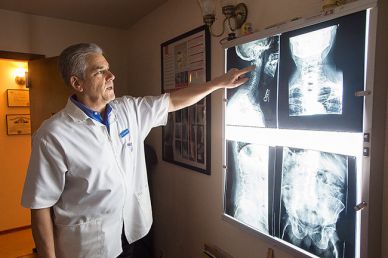SOFT TISSUE INJURIES
The most common type of injury in a car accident is known as a “soft tissue injury”. This means the connective tissue that holds you together—muscles, tendons, ligaments, nerves—get stretched, irritated, even torn if the impact was hard enough. If this happens, weakness and scaring may occur—what medically is called the “fibrosis of repair”—possibly creating chronic problems down the road for you. That’s what we want to prevent, and I think we all know at least one person who hasn’t quite been the same since being in an accident. I myself had a car accident in 2010, was injured, and have learned how to manage my injuries very well.

So how are these injuries detected?
First, a detailed history is obtained from you. We want to know exactly how the accident happened and how you were affected by it. Then a specific and thorough exam (orthopedic, neurological, chiropractic) as well as other functional tests to determine if you have a soft tissue injury. Special diagnostic tests and equipment can measure the extent of soft tissue damage.
Specific x-rays can be taken and analyzed using computerized techniques designed to find out if there has been any soft tissue injury or damage to your spine and ligaments according to the American Medical Association’s Guidelines on Injuries and Impairment.
Frequently Asked Questions
- I’m only suffering from sore muscles. Should l wait a month or two and if I’m not any better by then, get checked out?
My experience with my car accident injury patients has been with those who are examined and treated right after the accident. That’s because scar tissue start forming immediately which is medically called the “fibrosis of repair”. The best results occur using a combination of gentle chiropractic manipulation, stretching, specific exercises, traction, and natural whole food concentrate supplements and herbs to help your injured soft tissues heal faster.
- But I only received a little bump in the parking lot. There wasn’t even any damage to my car. How can I be hurt?
This is a very good question and one that we experience a lot. According to scientific research studies, the amount of injury to your automobile bears little
Relationship to the ultimate damage to your body.
Plus, an injury to your body depends upon the way your vehicle was struck,
how fast it was moving, your position in the car at impact, and how your vehicle responded to the impact and many other factors.
- Is going to the Emergency Room or taking medications all I need?
An emergency room’s main concern is that you do not have a life threatening
injury, not the type of soft tissue injury we are talking about here. Of course depending on the extend of the trauma to the body, the emergency room can be very helpful to rule out bone fractures or other internal bone injuries.
Most auto accident patients who go to the emergency room may be in pain, but
they generally do not have true life-threatening emergencies. The emergency
room doctor will check your vital signs—blood pressure for example, maybe even x-rays —to be sure you don’t have any life-threatening injuries and if everything checks out ok you will be given some pain medication and muscle relaxants and sent home and told to see a doctor if your pain persists.
But be aware! If you are in enough pain to take pain medication, then chances are you have suffered a soft tissue injury.

